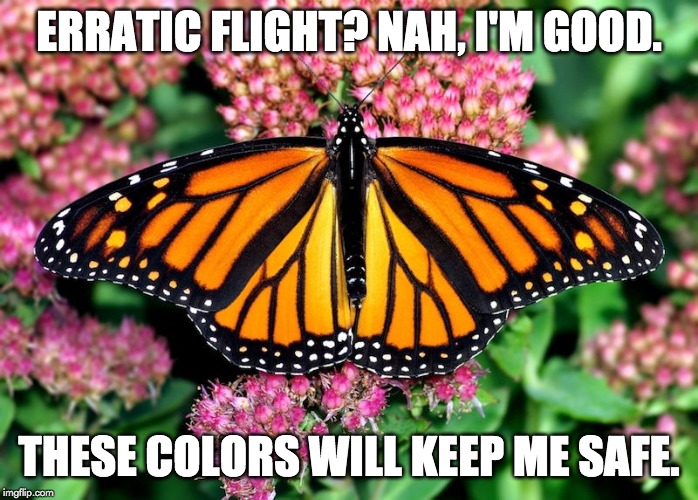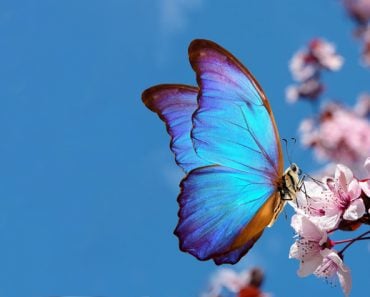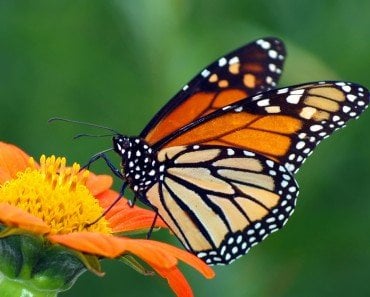Table of Contents (click to expand)
Although it may look like they’re out of control, butterflies’ irregular flight patterns is actually the rest of delicate manipulations of their body weight, allowing them to carefully manipulate their erratic flight, which makes it difficult for predators to catch them!
Depending on where you are in the world, if you’ve ever found yourself walking through a flower-filled field in the height of summer, there’s a good chance you’ve come across a butterfly or two. These majestic and diversely colored insects are some of the most beautiful and entrancing creatures of the natural world, seeming to worship nothing but the lure of flowers and their own mad style of flight.
If you pay attention to a single butterfly at a time, it’s difficult to ignore their seemingly random manner of flight. They dart and bob, changing directions and heights on a whim, making it impossible to know where they’ll move next. Unlike other insects, like bees or dragonflies, butterflies seem to lack any control of their “drunken” flight. Despite this apparent inability to maintain stable flight, butterflies flourish and are found all over the world. This naturally raises the question: why can’t butterflies seem to fly in a straight line?

Recommended Video for you:
The Flight Of The Butterfly
While watching the stumbling, rambling, seemingly drunken flight of a butterfly, it doesn’t make much sense. It takes a longer time to move between flowers and get anything done, and it seems to draw more attention to the insects, which surely can’t be good for survival. Butterflies, after all, are not equipped with many defense mechanisms.
However, researchers have found that the generation of such an erratic flight pattern is by design, as it makes it nearly impossible for a potential predator—bird, bat, larger insect, etc.—to predict where a butterfly will move next. Most creatures have certain limitations to their movement based on their exoskeleton or skeleton; essentially, this makes movements more predictable, particularly for a skilled hunter. In the case of butterflies, however, they have developed a number of techniques and physical adaptations that allow them to so masterfully control their flight, creating a complex dance that even the most sharp-eyed predator cannot decode.

Some of these physical adaptations involved the shape and composition of butterfly wings, which are more flexible than previously thought. Certain types of flapping generates unique airflow patterns, including vortices, that allow for such rapid changes in height and direction. These complicated upstrokes and wing flaps provide more lift and versatility in movement than the typical wing flaps of birds. In fact, researchers are working on duplicating some of the aerodynamic properties of butterflies in order to create miniature drones with similar capabilities.
Another fascinating study conducted at the National Taiwan University has revealed a unique physical adaptation that enables some of the butterflies’ mesmerizing flight. Using high-speed cameras and analyzing the movements of butterflies in a closed setting, the researchers identified a change in the body mass placement of butterflies in the instants before they change direction or height. Butterflies constantly rotate and tip their bodies during flight, which shifts their center of gravity and body weight, allowing them to utilize more of the energy with each wing flap. This perpetual movement of their main body mass helps them avoid the downward forces associated with each flap of the wing. This makes their flight more efficient and allows them to climb and plummet so rapidly, and in complete control.
Exceptions To The Rule
Some of you who just read the above section will be shaking your head, knowing that at some point in your memory, you saw a butterfly moving in a relatively straight line. You may not be wrong, as some butterflies don’t need to rely on their erratic flight patterns to deter potential predators. The most colorful butterflies you see in the wild may also be the most poisonous, as is the case for many creatures. The vibrant colors are a clear signal to predators—”I can afford to be this colorful because I taste terrible.” As a result of this, those butterflies who were guided through natural selection towards being poisonous or toxic to predators, as well as colorful, didn’t need to rely as much on physical adaptations to avoid being preyed upon.

Monarch butterflies, for example, some of the most recognizable and beloved butterflies in the world, are able to eat poisonous plants in their larval and caterpillar stage, and are thus poisonous as adults. They are also vibrantly colored (orange), so you may notice that their flight patterns are a bit more normal. They will glide for long periods and flap their wings similar to birds; while they certainly have the ability to fly erratically when in a swarm or when evading a predator, it isn’t their primary method of defense, and therefore not their constant behavior.
Butterflies And Alcohol
At the top of this article, we joked that butterflies often look as though they are drunk, since they can’t fly in a straight line. While this isn’t the reason for their unique flight patterns, some butterflies do have a taste for alcohol! As a whole, butterflies are attracted to sweet smells, like flowers and other sugary liquids, such as fermenting fruit and juice. Therefore, it should come as no surprise that butterflies like the occasional tipple if some alcohol has been spilled!
In particular, butterflies that hibernate through the winter require high levels of sugar throughout the autumn before they go into their hibernating state. As the end of summer approaches, you will see a higher concentration of butterflies, and many of them, if given half the chance, would gladly slurp up some sweet-smelling fermented fruit and alcohol. There are even butterfly farms in some parts of the world where hibernating butterflies are encouraged to drink alcohol leading up to the winter. Some of the insects get so drunk and docile after their feast that they can be picked up!
A Final Word
Even the most seemingly random phenomena in nature have a good explanation behind them. While most other animals that seem inept at navigation would make them easy prey, butterflies have instead mastered the art of chaotic flight through physical and behavioral adaptations.
References (click to expand)
- Chakravarthy, A., Albertani, R., Gans, N., & Evers, J. (2009, January 5). Experimental Kinematics and Dynamics of Butterflies in Natural Flight. 47th AIAA Aerospace Sciences Meeting including The New Horizons Forum and Aerospace Exposition. American Institute of Aeronautics and Astronautics.
- Fei, Y.-H. J., & Yang, J.-T. (2016, March 25). Importance of body rotation during the flight of a butterfly. Physical Review E. American Physical Society (APS).
- Betts, C. R., & Wootton, R. J. (1988, September 1). Wing Shape and Flight Behaviour in Butterflies (Lepidoptera: Papilionoidea and Hesperioidea): A Preliminary Analysis. Journal of Experimental Biology. The Company of Biologists.
- BROWER, L. P., & FINK, L. S. (1985, June). A Natural Toxic Defense System: Cardenolides in Butterflies versus Birds. Annals of the New York Academy of Sciences. Wiley.













